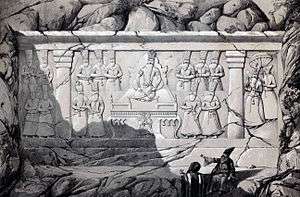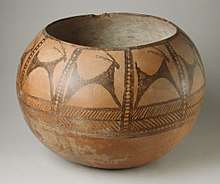Cheshmeh-Ali (Shahr-e-Rey)
Cheshmeh-Ali (Persian: چشمهعلی; "Spring of Ali") is an ancient recreational place, located in the south of Tehran and north of Rey in the country of Iran. The spring is spot in the neighborhood of Ebn-e Babooyeh, Tughrul Tower, and below the Rashkan castle and next to Rey Castle and Fath Ali shah inscription. In the past, carpet salers and people used to wash their carpets there, with their idea that the property of this spring water is good and clean for carpets and make them full lighter color by its mineral water.

History

The first signs of civilization in the Cheshmeh-Ali, including the ancient hills, towers and underground springs is related to the production of red terracotta with black-dark brown signs and shapes on them.
Archaeology

Cheshmeh Ali is a small Late Neolithic and Chalcolithic settlement located within the suburbs of modern-day Tehran, south of the Elburz mountains. It was excavated by Erich Schmidt in 1934-1936 for the University Museum in Philadelphia, also sponsored by the Boston Museum of Fine Arts. At that time, the site was far from Tehran. When Schmidt died in 1964, his work remained mostly unpublished.[1]
Cheshmeh Ali presents some typological parallels with the middle layers of Tepe Sialk.
Originally, Donald E. McCown offered three successive painted pottery traditions for northern Iran: the Sialk horizon, the Cheshmeh Ali horizon, and the Hissar horizon.[2]
The ceramic sequence at Cheshmeh Ali shows two millennia of occupation from the Late Neolithic through the Late Chalcolithic.[3]
The Cheshmeh Ali cultural complex generally defines a Transitional Chalcolithic on the Iranian Central Plateau dating between 5500 and 4800 BC.[4] Cheshmeh Ali ware is dated ca. 5500 BC. This painted pottery, also known as "Ismailabad ware", is found across northern Persia as far west as the area around Kashan, near Isfahan, and Qazvin to the north of there.[5]
Yet recent reexcavation of Cheshmeh Ali has also documented an earlier occupational phase. Chaff-tempered Neolithic soft-ware ceramics are also found here. These are usually decorated with painted geometric designs, and also have parallels to the early Sialk I material.[6]
References
- Cheshmeh Ali - A late Neolithic and Chalcolithic Village in northern Iran uakron.edu
- D. E. McCown, The Comparative Stratigraphy of Early Iran, Studies in Ancient Oriental Civilization 23, Chicago, 1942.
- Cheshmeh Ali - A late Neolithic and Chalcolithic Village in northern Iran uakron.edu
- KHARANAGHI, M. Hossein Azizi, THOMALSKY, Judith, KHANIPOOR, Morteza, JAFARI, M. Javad (2016), Archaeological Research at Tappeh Pahlavan, North Khorasan Province (Northeastern Iran); Report on the 2014 Season. Ancient Near Eastern Studies, Volume: 53 Pages: 59-79. At academia.edu
- Robert H. Dyson, CERAMICS: The Neolithic Period through the Bronze Age in Northeastern and North-central Persia. iranicaonline.org
- Lloyd R. Weeks, The Development and Expansion of a Neolithic Way of Life. in The Oxford Handbook of Ancient Iran, Edited by Daniel T. Potts; 2013 doi:10.1093/oxfordhb/9780199733309.013.0033
Bibliography
- Coningham, R. A., Fazeli, N. H., Young, R. and Donahue, R. (2004) “Location, Location, Location: A pilot Survey of the Tehran plain in 2003” Iran 42: 1-12.
- Fazeli, N. H., Coningham, R. A. E. and Batt, C. M. (2004) “Cheshmeh-Ali revisited: Towards an absolute dating of the Late Neolithic and Chalcolithic of Iran's Tehran Plain” Iran 42: 13-23.
- Matney, T. (1995) “Re-excavating Cheshmeh Ali and Notes from the Field, 1934-1936” Expedition 37(2): 26-38.
- Wong, E., C.A. Petrie, and H. Fazeli (2010) “Cheshmeh-Ali Ware: A Petrographic and Geochemical Study of Transitional Chalcolithic Period Ceramic Industry on the North Central Plateau of Iran” Iran 48: 11-26.